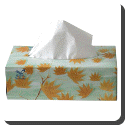 Fruity, musk, floral, woodsy… believe it or not, the human nose can detect the difference between nearly 1,000 different odours. Our nose is very sensitive to delicate variations in smell. To cater to the need ‘to smell good’, perfume manufacturers churn out innovative new fragrances all the time.
Fruity, musk, floral, woodsy… believe it or not, the human nose can detect the difference between nearly 1,000 different odours. Our nose is very sensitive to delicate variations in smell. To cater to the need ‘to smell good’, perfume manufacturers churn out innovative new fragrances all the time.
Perfume manufacturers spend a lot of money on making a perfume, research, bottling and advertisements. That’s not all, sometimes they even put the fragrance on a page in a popular magazine so that readers can sample the scent. A bit like a sniff preview!
Since the smell is released by rubbing or scratching the paper surface, this method is popularly known as ‘scratch and sniff’
Smell spell: a new way to sell
Do you know how they perfume paper? No, they do not spray the page with perfume. If they did that, the smell wouldn’t stay. It would vanish by the time you buy the magazine. Actually the ‘scented’ paper is coated with teeny capsules that contain the perfume. These itsy-bitsy containers cannot be seen with the naked eye. They can only be seen under a microscope.
The capsules are made of a delicate plastic that breaks easily when rubbed or scratched. This technique is known as microencapsulisation (pronounced mykro-n-capsu-lie-sation. Where micro means ‘small’ and encapsulisation means ‘within a capsule’.)
Sometimes perfume manufacturers use a different, less complicated method. They mix the perfume essence with water and use a machine, with an extremely fine nozzle, to spray minute water droplets on the paper surface.
These fine droplets are then covered with a very thin plastic sheet. When the reader rubs a finger on the highlighted portion of the page, the protective plastic coating breaks and releases a whiff of the perfume.
 Kids Portal For Parents India Kids Network
Kids Portal For Parents India Kids Network






